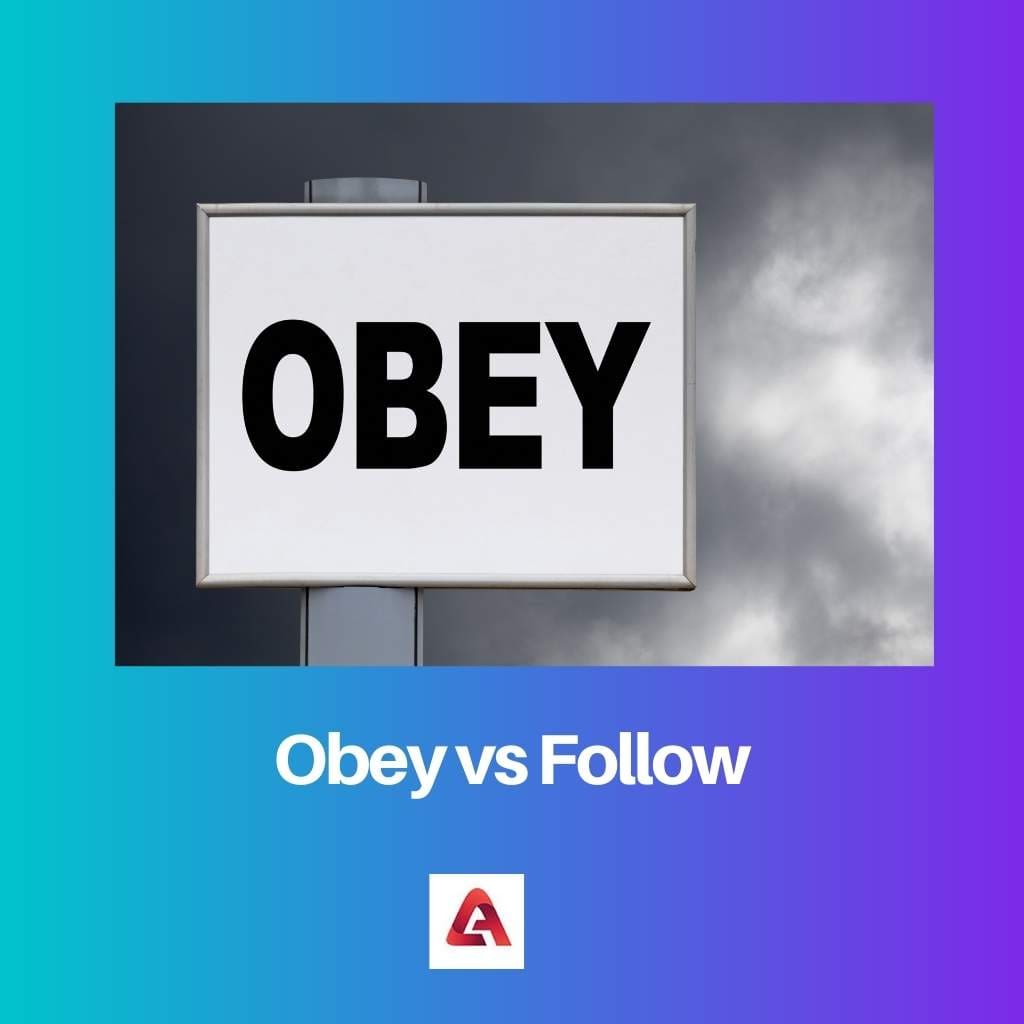In English, the term “follow” has a similar meaning to “obey,” although it differs in several ways. To put it another way, the word “follow” has a new meaning.
As a result, it has a broader scope than Obey. Obey is a word that has no further meanings. As a result, its application in the English language is restricted.
As a result, this term is frequently referred to as a “specialized term.” When it comes to intensity, Obey is more intense than its opponent.
Key Takeaways
- Obey implies following orders or commands without question or hesitation.
- Follow implies going along with someone or something willingly or as a choice.
- Obey can have negative connotations of blind obedience or subservience while following can be more neutral or positive.
Obey vs Follow
Obey is and English word which means to do as you are told or to accomplish what you are instructed. It doesn’t have more meaning, and it is termed a specialized word. Follow is an English word and it is mainly and normally used as a verb, and it means to go after something or to remain behind it.

Obey is a more binding term than obey.
It indicates that if a student is required to obey some orders issued by his or her teacher, principal, or parents, the student must comply with those orders, and if he or she does not, the student must face the consequences in the form of some punishment.
Obeying necessitates a greater amount of force and emotion. However, in this case, the person who is being urged to follow does not hold any power.
The term “follow” is more freely employed and has a less constraining connotation.
It means that if someone is requested to follow a teacher, colleague, batchmate, friend, leader, or anybody else, it may or may not be in the individual’s best interests to do so.
Other times, though, the Individual is required to follow the directions strictly. When a person is required to follow orders, he or she substitutes the directives for guidelines.
Comparison Table
| Parameters of Comparison | Obey | Follow |
|---|---|---|
| Possession of Meanings | Does not possess more meanings. | Possesses lesser meanings. |
| Degree of intensity | High | Low |
| Voluntary | Less voluntary | More voluntary |
| Binding | More binding | Less binding |
| Choices | Gives fewer choices | Gives more choices |
What is Obey?
Obey is one of those words that has no additional meanings. As a result, its use in the English language is restricted. As a result, this word is frequently referred to as a “specialized word.”
When the degree of intensity is taken into account, Obey’s intensity is higher than that of its equivalent. The word ‘obey’ literally means to do what you are instructed.
Orders can be general or very specific. There are two types of orders: specific and non-specific.
Specific orders are those that are currently in effect, and non-specific orders are those that should be followed in general. Obey is a term that is used less voluntarily and has a stronger connotation.
It indicates that if a student is required to obey some orders issued by his or her teacher, principal, or parents, the student must comply with those orders, and if he or she does not, the student must face the consequences in the form of a penalty.
Obeying necessitates a greater level of force and emotion. On the other hand, the individual being requested to comply is not in a position of power.
Either the individual obeying the orders acts as a subordinate, or he genuinely cares about the one who is ordering him.
What is Follow?
Follow is a term in English that has a similar meaning to “obey” but differs in several ways. To put it another way, the word “follow” has a deeper connotation.
As a result, it has a wider range of applications than Obey. The intensity with which the phrase ” Follow ” is less than the intensity with which the phrase ” Obey ” is used.
‘Follow’ is primarily used as a verb. One of the most popular meanings is to pursue something or to remain behind it. This term can also refer to something that comes after something else.
Perhaps in the form of a schedule or a list. The term “follow” is used more freely and has a less constraining connotation.
It means that if a student is urged to follow his or her instructor, colleague, batchmate, buddy, leader, or anybody else, it may or may not be in the student’s best interests to do so. Other times, though, the Individual is expected to obey the directions strictly.
When a person is told to follow commands, he or she substitutes the orders for guidelines. The individual getting the commands now has more options, such as whether to obey them, ignore them, or follow them in his way.

Main Differences Between Obey and Follow
- Obey is such a word that does not possess more meaning. Thus, its use is limited in the world of the English language. Therefore this word is regarded as a “specialized word.” On the other hand, Follow is a word in English-language that possesses a similar meaning to “Obey” but still differs from it in various senses. In other words, the word “Follow” possesses more meaning. Thus, its use is less limited than Obey.
- When the degree of intensity is taken into consideration, the intensity with which Obey is used is more intense than the intensity of its counterpart. On the other hand, the intensity with which Follow is used is less intense than the intensity of the use of the word, Obey.
- ‘ Obey’ literally means to accomplish what you are told. The orders can be either non-specific or even specific. Specific are those existing orders, and non-specific are those which should be obeyed in general. On the other hand, ‘Follow’ and is mainly regarded as a verb. One of the common meanings it possesses is to go after something or to stay behind it. This word is also used to define something which comes after something other, maybe in a schedule or list.
- The word Obey is used less voluntarily, and it is more binding. It means that if a student is asked to obey some orders given by his or her teacher, principal, or parents, then the child has to obey it, and in case he or she doesn’t, then the child have to face the consequences in the form of some punishment. On the other hand, the word Follow is used more voluntarily and is less binding. It means that if someone is asked to follow their teacher, colleague, batchmate, friend, leader, or anyone else, sometimes it depends upon the individual’s wish to follow them. However, at other times the Individual is also strictly asked to follow the orders.
- Obeying involves more forcefulness and emotions attached to it. However, here the person who is asked to obey does not possess any position of power. Either the person obeying the orders acts as a subordinate or cares a lot about the other person who orders him. On the other hand, when a person is asked to follow the orders, he or she uses the orders as a substitute for guidelines. Here the person receiving the orders possesses more choices as to whether to follow them, unfollow them, or follow the orders in his way.

- https://heinonline.org/hol-cgi-bin/get_pdf.cgi?handle=hein.journals/stflr46§ion=31
- https://journals.sagepub.com/doi/pdf/10.1177/026119299202000401

The detailed analysis and examples of obey and follow provide a clear distinction between the degree of intensity and choice associated with each word. It’s an informative read.
It’s quite intriguing to understand that obey does not possess more meanings, and it is considered a specialized word. The comparison table provided is very helpful.
The main differences highlighted between obey and follow are elucidated well in the article. It’s beneficial to understand the nuances of language use and meaning.
The analysis of obey and follow provides a comprehensive understanding of how each term is used and the implications associated with them.
The comparison between obey and follow in the context of voluntary and binding actions offers valuable insight into the meaning and applications of these words.
This is an interesting analysis of the differences between obey and follow. The article dives deep into the nuances of these words.
The differentiation of obey and follow in terms of intensity is well explained in the article. It’s essential to distinguish the connotations of these words.
The in-depth explanations of obey and follow as verbs with specific examples clarify the differences between these terms and how they are employed in language.